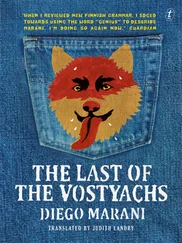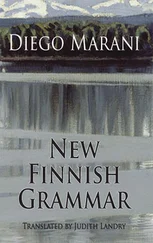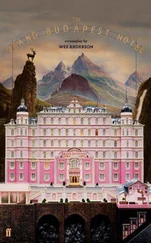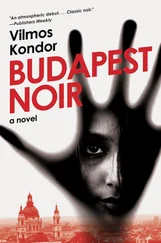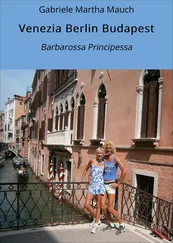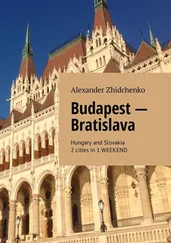All this is seen from a certain distance, as if the painter has been viewing the camp through binoculars from a window a hundred metres away. A lugubrious collective vision yet at the same time intense and radiant. The bodies have been painted with quick, firm lines, in which white and black alternate and run into one another. There is something very cruel yet at the same time affectionate in this presentation of a monstrous and ferocious daily existence as everyday normality. The painter seems to have had intimate knowledge of these camps. He seems to have reproduced with his eyes closed his memory of those numbed and mutilated bodies.
A bell rings. An attendant passes, rapidly waving a hand as if to indicate closing time. Hans and Amara go down the infinite stairs of the museum to a tiny eating-place, where they sit down at a table covered with a waxed cloth. They order Hungarian goulash, the cheapest thing on the menu, which is written in chalk on a blackboard hanging on the wall.
‘Would you like a beer?’
‘No, thank you.’
‘Impressive, that picture.’
‘But that’s all we looked at. We missed my beloved Vermeer.’
‘We’ll come again.’
‘Who do you think painted that camp?’
‘Someone who must have known it from the inside.’
‘Don’t you think a painter might have imagined it and described it without having been an inmate there?’
‘Not with that precision of detail.’
‘So for you art is only direct reportage?’
‘I think so.’
‘How would you compare that to Goethe or Dante?’
‘Goethe tells ominous fables. Dante invents. No one believes in his Inferno . It’s the delirium of a catastrophical mind. What enchants is his language.’
‘And Sebastopol for Tolstoy?’
‘Tolstoy lived through that war; he was there, even if only as an observer.’
‘What about Manzoni and the seventeenth century?’
‘When a writer writes about something not experienced directly, he sets in motion the artifice of the imagination. An artifice that remains indigestible to the reader.’
‘So we should throw away half the literature of the world. And nearly all modern painting.’
‘The Vermeer you love so much describes his own world, his time, his spaces.’
‘And Rembrandt’s Saul? ’
‘Painters love mythology, but they have a trick. They make it into direct reportage by introducing their wives and children. Saskia is there in all Rembrandt’s paintings. That’s how he constructs his mythology. But in the long run tricks are boring.’
‘So according to you no one can tell a story unless they have lived it directly.’
‘No, what I’m saying is that imagination leads to fables and fables to mental regression. Nothing can have as much force as what you have lived in your own skin.’
‘Then you want artists to be egocentric narcissists. With any outward-looking perspective on the world, on past times, or on faraway stories, becoming a profanation and a crime.’
‘I wasn’t talking of crimes. Let’s leave those to Stalin who sent so many artists to their deaths because they presented a sad and contradictory reality that he disliked. But even if they had painted the optimistic and triumphalist world he wanted from them, they would still have been capable of eventually changing their minds, so he got rid of them before they even had time to regret being his friends.’
‘Isn’t that too reductive?’
‘I remember a story once told me by a friend who was a sculptor. It seems that one day, at the celebrations at a great provincial factory in the Soviet Union that had achieved maximum productivity, a famous painter brought along a work that had been commissioned from him: he had been asked to paint the factory at work, in a happy festive atmosphere with several Stakhanovites receiving prizes. Stalin himself had been invited to the celebrations and although he had not promised to come, he arrived unexpectedly in a helicopter from Moscow, creating enthusiasm and panic. The painter was terrified of showing his enormous new canvas. Even though he had put into it everything expected of him: the workers, the machinery, the prize-giving, and even a beautiful big symbolic figure of Father Stalin with a benevolent smile on his lips.’
‘The painter had agreed to do all this?’
‘Not voluntarily, but he had no choice. If he’d refused, he would have risked death. That was the climate of the times.’
‘And was Stalin happy?’
‘He spent a long time studying the painting he’d commissioned, smiling with gratification as he noted that all his requirements had been met to the letter; he even liked the portrait of himself, something that didn’t happen too often. He appreciated the fact that he had been beautified and presented as taller than he actually was, and surrounded by a halo of light that made him look almost divine. The painter, watching the dictator gradually running his gaze from one part of the picture to another and nodding with satisfaction, felt excited, almost euphoric. But suddenly he saw Stalin look surprised and worried. The great Father of his Country lifted a finger and pointed to a figure at one side, the silhouette of a worker standing with his arms folded: ‘And who is this?’ Everyone stared in consternation. Who was that man so obviously not working? ‘Why isn’t he working like all the others? Comrade, are you trying to create an incentive to strike? What do those folded arms and that self-satisfied face tell anyone who looks at the picture? You have included a saboteur in this representation of a model factory for exhibition at the Eighteenth Congress of the Communist Party of the Soviet Union!’ The terrified artist stammered the reason the worker in question was just smiling and doing nothing more was because he was gazing at the great Father Stalin. But Stalin wasn’t listening. Next day the painter was arrested at his house by two police officers and taken off to prison.’
‘What a sad story.’
‘The story of an era. And we haven’t finished with it yet.’
‘Sleep well?’
‘Sickening dreams.’
‘Better than lying awake.’
‘What shall we do this morning?’
‘What about looking for Orensteins in the phone book?’
‘Done already. I found a Theodor Orenstein. Does that mean anything to you?’
‘I’ve looked too. I found another. Name of Elisabeth.’
‘I called this Theodor. He’s a painter and lives in a little street near Stephansplatz, off Bäckerstrasse in the city centre.’
‘Did you make an appointment?’
‘He’s expecting us at ten.’
Theodor Orenstein receives them in stained coloured trousers and a woollen blue and black check shirt. He seems happy to see them, even if they have clearly interrupted his work on a large painting propped against the wall that features angels flying over a huddle of reddish roofs.
The man with the gazelles offers to translate but the painter is determined to speak Italian. In fact, it really seems he wants to take the chance to practise a language grown rusty in his memory. He says he’s happy to meet them, that he loves Italy, and that he would like a clearer picture of what they want from him.
He listens attentively to the story of the Emanuele Orenstein whose fate is the object of the young Italian woman’s investigation. Meanwhile he offers them a glass of beer and some olives ‘from Greece’. He is a man of about forty. Apparently living alone. His tiny studio flat opens onto an equally minute and lovingly cultivated garden. The room is divided by a curtain behind which can be glimpsed a bed with a red coverlet. There is little furniture: a simple shelf, a rough table covered with a confusion of brushes and small tubes of paint, a bench by the wall and two rush-seated chairs cluttered with rags. A huge radio set dominates the corner under the window. On top of the radio, stretched like a pasha on a yellow cushion, an enormous white cat follows them with its eyes without moving a muscle. Amara swallows a mouthful of beer, nibbles an olive, and asks the painter whether he has ever had a relative called Emanuele Orenstein.
Читать дальше


